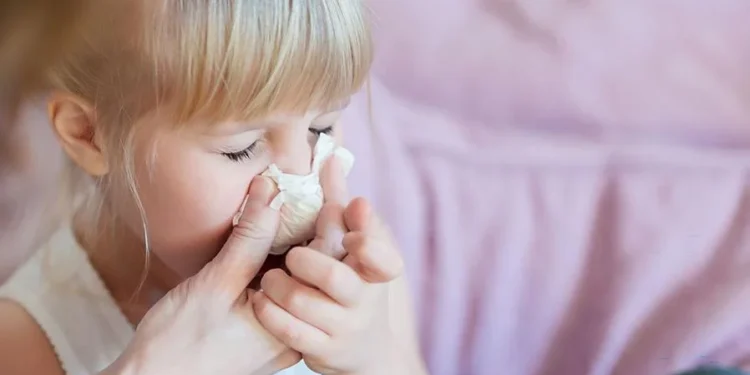Nasal congestion happens when blood vessels and tissue in the nasal cavity fill up with too much fluid. It can make it hard to sleep and lead to problems like a sinus infection (sinusitis). A baby may also have trouble feeding if he or she is congested. There are some tell-tale signs that can help you tell the difference between viral and bacterial infections.
For example, if a child has a runny nose, the colour of the discharge is an important clue. Clear and watery discharge at first usually come from a virus, though the mucus may turn white, green, or yellow for a few days before it turns clear again.
Blocked noses can be caused by a mild infection, like the cold or flu, but it’s worth checking if a child has accidentally blocked a nostril themselves.
A gentle option is to wash away the mucus that’s causing the blockage, so the child can breathe more easily. A natural treatment like a nasal spray of saline drops can help to do this.
Some of the causes of nasal congestion include:
• Infections: the common cold and other respiratory tract infections, including influenza (flu) and sinusitis.
• Allergies, including hay fever.
• Persistent rhinitis. When temperatures start turning colder and kids are inside and interacting with each other in greater numbers, cold and flu season inevitably follows.
Children under the age of 6, and particularly under age 2, are at an
especially high risk during cold and flu season. Advise on keeping the child hydrated to help reduce cold and flu symptoms and make them feel better. Fevers can result in dehydration. Children suffering with the cold or flu may not feel as thirsty as they normally would, and they may be uncomfortable when drinking, so it’s important to encourage them to drink plenty of fluids.
Medicated nasal sprays aren’t recommended for young children. Fortunately, there are several easy ways to clear up a stuffy nose without medication.
Use a cool-mist humidifier in the child’s room. This will help break up mucus. Another option is using a saline nasal spray or drops, which makes thin mucus easier to blow out or remove with a bulb syringe. This is especially helpful before feeding and bedtime.
Tips for using a nasal spray
• Get the timing right. It’s hard to use a nasal spray when a baby’s feeling wriggly, so try dosing them when they are nice and relaxed, like after a bath or a feed.
• If a child’s under 2:
1. Lay the child down and turn their head to one side.
2. It’s sometimes helpful to lay them on a pillow, so you can tilt their head back slightly.
3. Put the nozzle into a nostril and press the spray head once.
4. Then repeat in the other nostril.
• If they’re over 2:
1. Put the nozzle into one nostril, holding the bottle vertically.
2. Press the other nostril closed.
3. Press the spray head once and spray deeply, asking your child to breathe in at the same time.
4. Then repeat in the other nostril.
• Don’t worry about misfires If a little spray gets in their eye, don’t panic. It may surprise them a little but saline solution is very gentle and shouldn’t cause any harm.
• If it is tricky to use a nasal spray with a young baby, try using nasal drops instead, as some people find these easier.
When to Refer
Patients presenting with any of the following should be referred urgently for physician review:
• Periorbital oedema/erythema (cellulitis)
• Displaced globe
• Double/blurred/reduced vision
• Ophthalmoplegia
• Severe unilateral or frontal headache (worse than any previous)
• Frontal swelling
• Signs of sepsis or meningitis
• Reduced level of consciousness
• Persistent vomiting
Additionally, physician review should be recommended for rhinosinusitis patients presenting with associated shortness of breath, wheeze, stridor, dehydration, or history of immunocompromise, and failure to respond to supportive measures.
Advice for Parents
Moisture and warmth can help too. Try advising a parent to take the child into the bathroom while they run a steamy shower or bath. Advise the parent to make sure their little one gets plenty of restful sleep – this will really help give them the strength they need to recover. If the child is older than one, advise the parent to prop up the child’s pillow. It can help the child breathe more easily while they sleep.
A range of OTC products for young children are available in pharmacy, such as the Klearvol range of natural oils, pillow sprays and vapour rubs.
A range of plug-in products which release vaporised oils into the child’s room or vapour rubs are also available for young children.
Key Points:
All children are prone to congestion and colds.
Symptoms include; Stuffy nose, irritability.
An infant will have difficulty communicating their symptoms.
Steam, moisture and warmth can help to alleviate symptoms.
Appropriate medications, including decongestants for adults or older children should not be used on young child.









